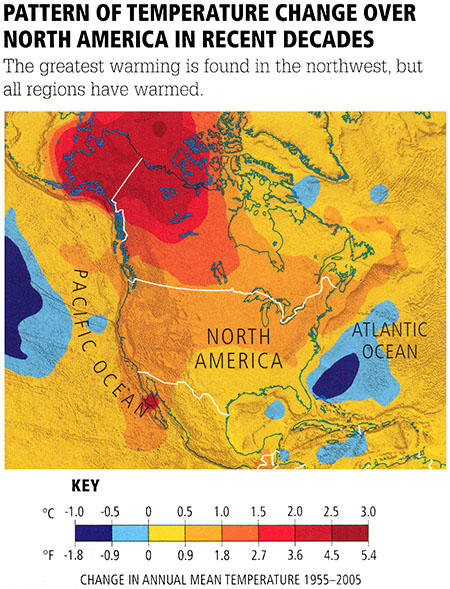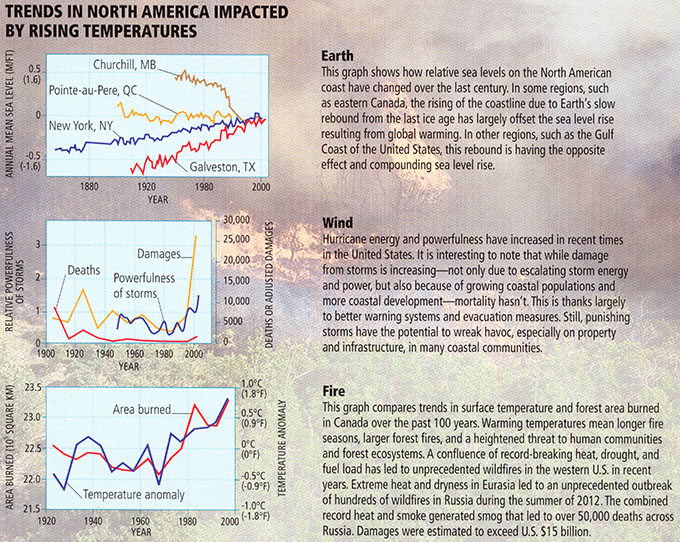We have already seen that climate change is likely to increase the frequency and severity of many types of severe weather impacts, including heat waves, intense precipitation events, and more intense hurricanes.
In North America, we have already seen increased damages, likely related to these increases. Among these is the rise in tropical storm-related damages (though there is some debate about precisely how much of a role has been played by the increase in storm intensity, and how much of a role has been played by increases in coastal infrastructure, real estate values, etc.). We have also seen an increase in damages due to increases in "fire weather", i.e., meteorological conditions such as warm and dry weather, which favor destructive wildfires.

© 2015 Pearson Education, Inc.

Earth
This graph shows how relative sea levels on the North American coast have changed over the last century. In some regions, such as eastern Canada, the rising of the coastline due to Earth's slow rebound from the last ice age has largely offset the sea level rise resulting from global warming. In other regions, such as the Gulf Coast of the United States, this rebound is having the opposite effect and compounding sea level rise.
Wind
Hurricane energy and powerfulness have increased in recent times in the United States. It is interesting to note that while damage from storms is increasing--not only due to escalating stomr energy and power, but also because of growing coastal populations and more coastal development--mortality hasn't. This is thanks largely to better warning systems and evacuation measures. Still, punishing stomrs have the potential to wreak havoc, especially on property and infrastructure, in many coastal communities.
Fire
This graph compares trends in surface temperature and forest area burned in Canada over the past 100 years. Warming temperatures mean longer fire seasons, larger forest fires, and a heightened threat to human communities and forest ecosystems. A confluence of record-breaking heat, drought, and fuel load has led to unprecedented wildfires in the western U.S. in recent years. Extreme heat and dryness in Eurasia led to an unprecedented outbreak of hundreds of wildfires in Russia during the summer of 2012. The combined record heat and smoke generated smog that led to over 50,000 deaths across Russia. Damages were estimated to exceed U.S. $15 billion.
© 2015 Pearson Education, Inc.
We saw earlier in this lesson that shifting water resources represent a potential climate change threat. In Europe, for example, both extreme drought and flooding due to intense rainfall are likely to incur damages. More powerful winter storms are likely to impact the economies of both Europe and North America (see, e.g., this news article discussing the impact of especially severe winter storms during 2011 winter on air travel in North American and Europe).

Selected potential climate change impacts in various parts of Europe:
- More frequent forest fires
- Biodiversity losses escalate
- Negative impact on summer tourism
- Heat wave impacts grow more serious
- Cropland losses as well as losses of lands in estuaries and deltas
- Thawing of permafrost
- Substantial loss of tundra biome
- More coastal erosion and flooding
- Greater winter storm risk
- Shorter ski season
- More Coastal flooding and erosion
- Stressing of marine ecosystems and habitat loss
- Increased tourism pressure on coasts
- Greater winter storm risk and vulnerability of transport systems to high wind conditions
- Increased frequency and magnitude of winter floods
- Heightened health threat from heat waves
- Decreased Crop yield
- More soil erosion
- Increased salinity of inland seas
- Severe fires in drained peatland
- Disappearance of glaciers
- Shorter snow-cover period
- Upward shift of tree line
- Severe biodiversity losses
- Shorter ski season
- More frequent rock slides
© 2015 Pearson Education, Inc.
